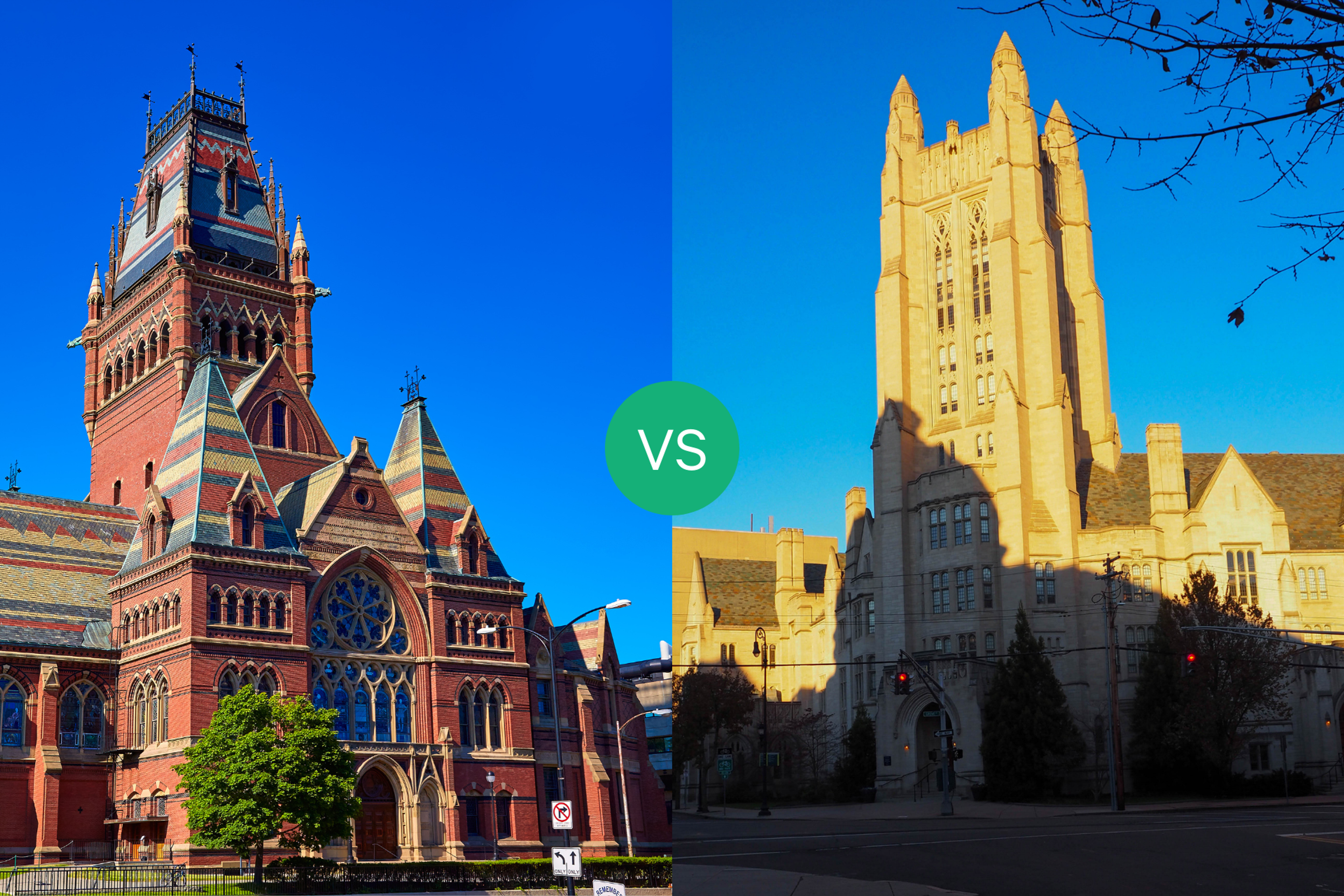Stanford Law School Vs. University of California--Berkeley School of Law: An In-Depth Comparison
Discover the key differences between Stanford Law School and University of California--Berkeley School of Law in this comprehensive comparison.
Posted June 13, 2025

Table of Contents
Stanford Law School and the University of California--Berkeley School of Law are two of the most highly respected law schools in the United States. They both offer excellent education, experienced faculty, and extensive resources to help students launch successful careers in law. But which one is the best fit for you? In this in-depth comparison, we'll take a look at all the key factors to help you make an informed decision.
Location and Campus Comparison of Stanford Law School and UC Berkeley School of Law
When it comes to location, these two schools couldn't be more different. Stanford Law School is situated in Palo Alto, California, in the heart of Silicon Valley, while UC Berkeley School of Law is in Berkeley, California, about 40 minutes away from San Francisco. Both campuses are beautiful and well-equipped with modern facilities.
Students at Stanford Law School enjoy a serene and relaxed environment, surrounded by the natural beauty of the area. The campus is akin to a secluded oasis with lush trees, quiet walkways, and tranquil water features. In contrast, UC Berkeley School of Law's campus is located near the bustling city of San Francisco and has stunning views of the San Francisco Bay. Here, students can enjoy the intellectual vibrancy of a bustling city.
Another notable difference between the two campuses is their size. Stanford Law School's campus is relatively small, with only a few buildings and a limited number of classrooms. This creates a tight-knit community where students and faculty can easily interact and collaborate. On the other hand, UC Berkeley School of Law's campus is much larger, with multiple buildings and a wide range of facilities. This allows for a more diverse range of activities and events, as well as more opportunities for students to explore different areas of law.
Academic Programs and Curriculum at Stanford Law School vs. UC Berkeley School of Law
Both law schools offer a wide range of academic programs in various legal fields, including corporate law, environmental law, intellectual property law, and international law. Stanford Law offers a six-week program in Comparative and International Law, while UC Berkeley School of Law has a five-week program called International & Comparative Law.
Both programs are designed to give students a deeper understanding of the legal systems around the world, and how they interact with one another. Additionally, both law schools have unique experiential learning programs that allow students to gain practical experience in legal practice.
However, there are some differences in the curriculum between the two law schools. Stanford Law School places a greater emphasis on interdisciplinary studies, offering joint degree programs with other schools at Stanford University, such as business, education, and engineering. On the other hand, UC Berkeley School of Law has a strong focus on public interest law, with a variety of clinics and programs dedicated to social justice issues, such as the Death Penalty Clinic and the International Human Rights Law Clinic.
Faculty and Staff: A Comparative Study of Stanford Law School vs. UC Berkeley School of Law
Faculty is a crucial aspect of any law school. Both Stanford Law School and UC Berkeley School of Law have faculty members who are experts in their fields and are highly respected in the legal community.
Stanford Law School has over 100 faculty members, including tenured professors, visiting professors, and clinical professors. The faculty includes former Supreme Court clerks, Fulbright scholars, and leading experts in various legal fields. Similarly, UC Berkeley School of Law has over 70 full-time faculty members with expertise in a wide range of legal topics, from human rights law to antitrust law.
However, there are some differences in the faculty composition between the two schools. Stanford Law School has a higher percentage of faculty members who hold a PhD in addition to their law degree, while UC Berkeley School of Law has a higher percentage of faculty members who have experience working in government or public interest organizations. This difference in background and expertise can lead to different teaching styles and perspectives in the classroom.
Admissions Process: How to Get into Stanford Law School and UC Berkeley School of Law
Both Stanford Law School and UC Berkeley School of Law are highly selective, with acceptance rates of around 10% or less. To gain admission to either school, you'll need to have a competitive LSAT score, a strong undergraduate GPA, and a compelling personal statement.
Additionally, both schools will review your letters of recommendation, work experience, undergraduate coursework, and extracurricular activities to get a complete picture of your potential as a law student. It is also important to note that both schools give special consideration to students who have overcome significant obstacles, such as financial hardship or academic adversity.
Student Life Comparison: Stanford vs. UC Berkeley
Students at both Stanford Law School and UC Berkeley School of Law enjoy a vibrant campus life, with numerous clubs and organizations catering to a wide range of interests and backgrounds. At Stanford Law School, there are over 50 student groups, including moot court, legal aid, and the Stanford Law and Technology Association. UC Berkeley School of Law offers more than 30 student organizations, including the International Law Society, the Women of Color Collective, and the Asian Pacific American Law Students Association.
Job Prospects for Graduates from Stanford Law School and UC Berkeley School of Law
One of the primary reasons students attend law school is to secure high-paying, fulfilling jobs. Both Stanford Law School and UC Berkeley School of Law have impressive employment rates, with many graduates landing top jobs with prestigious law firms, non-profits, and government agencies.
According to the American Bar Association, the employment rate for Stanford Law School graduates is around 87%, while UC Berkeley School of Law graduates have an employment rate of around 92%. Graduates from both schools typically earn salaries in the six-figures and have a wide range of job prospects to choose from.
Alumni Network Comparison: Stanford vs. UC Berkeley
The alumni network from either law school is a valuable resource for graduates to connect with other professionals and gain career advice. Stanford Law School boasts an accomplished alumni network, including over 18,000 individuals who are leaders in various legal fields, including business law, human rights law, and academia. UC Berkeley School of Law also has a robust alumni network, including more than 13,000 alumni who occupy senior positions in a wide array of industries.
Tuition Fees and Financial Aid Options at Stanford Law School and UC Berkeley School of Law
Both Stanford Law School and UC Berkeley School of Law are expensive propositions, with annual tuition and fees amounting to over $60,000 per year. However, both schools provide various financial aid options to help students mitigate the cost of attending law school. These include need-based financial aid, merit scholarships, and work-study programs.
Education Quality Assessment: Which law school is better, Stanford or UC Berkeley?
Both law schools are exceptional and are among the best in the country. However, which one is better for you may depend on your individual needs and interests. Stanford Law School is highly ranked both globally and nationally, regularly placing among the top five law schools in the country. UC Berkeley School of Law is also highly regarded, it is currently ranked in the top 10 by US News & World Report.
Student Societies, Clubs, and Organizations at Stanford Law School vs. UC Berkeley School of Law
Both law schools offer numerous student societies, clubs, and organizations to enrich the student experience. These include student-run publications, advocacy groups, and sports teams, among others. Some notable groups at Stanford Law School include the American Constitution Society, the Asian and Pacific Islander Student Organization, and the Black Law Students Association. Similarly, UC Berkeley School of Law has a wide range of student societies, such as the Death Penalty Clinic, the Environmental Law Society, and the Human Rights Center.
Campus Safety and Security Measures Compared: Stanford vs. UC Berkeley
Both schools maintain robust safety and security measures to keep students and staff safe. Stanford Law School has a dedicated Department of Public Safety, which provides on-campus security, emergency response, and crime prevention services. Similarly, UC Berkeley School of Law has its Department of Public Safety, which ensures the safety of students, faculty, and staff through security patrols, crime prevention initiatives, and emergency management planning.
Research Opportunities for Students at Stanford Law School vs. UC Berkeley School of Law
Both law schools have numerous research centers and institutes that offer students opportunities to conduct cutting-edge research in legal areas of their interest. Stanford Law School has fifteen research centers, including the Center for International Security and Cooperation, the Stanford Institute for Economic Policy Research, and the Steyer-Taylor Center for Energy Policy and Finance. UC Berkeley School of Law is also home to several research centers, such as the Center for the Study of Law and Society, the Kadish Center for Morality, Law & Public Affairs, and the Berkeley Center for Law & Technology.
Faculty Experience and Expertise in Specialized Legal Fields: A Comparative Analysis
Stanford Law School and UC Berkeley School of Law both have faculties that bring a wealth of experience and expertise in a wide range of legal fields. At Stanford Law School, faculty members have expertise in specialized areas such as technology law, cyberlaw, and intellectual property law. UC Berkeley School of Law's faculty members have specialized knowledge in fields such as environmental law, health law, and labor law. Therefore, both law schools offer a unique area of expertise to prospective students.
Student Reviews, Testimonials, and Feedback about Stanford Law School vs. UC Berkeley School of Law
What do actual students think about these law schools? Those who have attended both schools express appreciation for the unique benefits each provides. Stanford Law School has a reputation for being highly selective, rigorous, and competitive. The education is worth the investment, provided one can manage the workload and expectations. Students at UC Berkeley School of Law often praise the supportive and inclusive atmosphere, as well as the ability to make meaningful connections in the Bay Area legal community. While both schools are demanding, students at each feel they come out of the experience prepared for a fulfilling legal career.
Conclusion
In conclusion, both Stanford Law School and UC Berkeley School of Law are excellent law schools with impressive programs, experienced faculty, and extensive resources. The location, campus environment, and specialties offered by each institution will ultimately determine which one is the best fit for you. Therefore, we encourage you to take the time to research both law schools, visit their campuses, talk to current students, and ask as many questions as needed before making a final decision.











